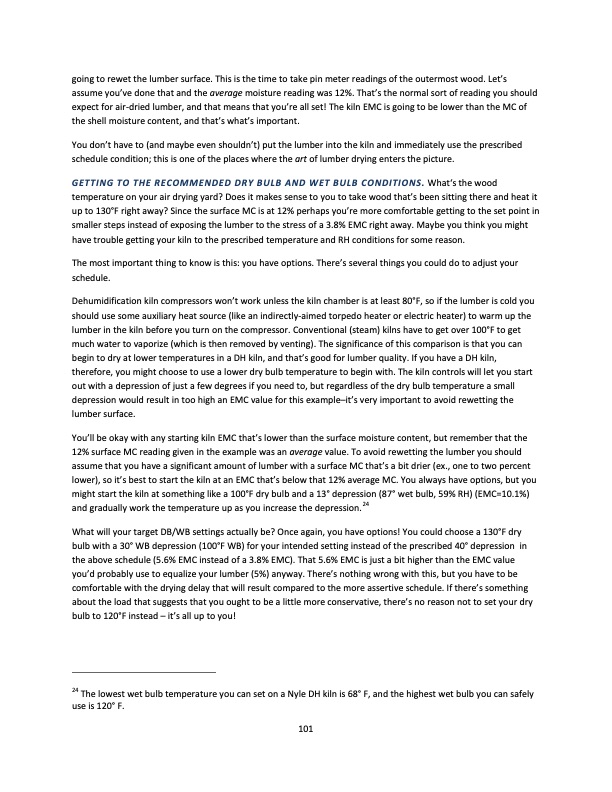
PDF Publication Title:
Text from PDF Page: 101
going to rewet the lumber surface. This is the time to take pin meter readings of the outermost wood. Let’s assume you’ve done that and the average moisture reading was 12%. That’s the normal sort of reading you should expect for air-dried lumber, and that means that you’re all set! The kiln EMC is going to be lower than the MC of the shell moisture content, and that’s what’s important. You don’t have to (and maybe even shouldn’t) put the lumber into the kiln and immediately use the prescribed schedule condition; this is one of the places where the art of lumber drying enters the picture. GETTING TO THE RECOMMENDED DRY BULB AND WET BULB CONDITIONS. What‘s the wood temperature on your air drying yard? Does it makes sense to you to take wood that’s been sitting there and heat it up to 130°F right away? Since the surface MC is at 12% perhaps you’re more comfortable getting to the set point in smaller steps instead of exposing the lumber to the stress of a 3.8% EMC right away. Maybe you think you might have trouble getting your kiln to the prescribed temperature and RH conditions for some reason. The most important thing to know is this: you have options. There’s several things you could do to adjust your schedule. Dehumidification kiln compressors won’t work unless the kiln chamber is at least 80°F, so if the lumber is cold you should use some auxiliary heat source (like an indirectly-aimed torpedo heater or electric heater) to warm up the lumber in the kiln before you turn on the compressor. Conventional (steam) kilns have to get over 100°F to get much water to vaporize (which is then removed by venting). The significance of this comparison is that you can begin to dry at lower temperatures in a DH kiln, and that’s good for lumber quality. If you have a DH kiln, therefore, you might choose to use a lower dry bulb temperature to begin with. The kiln controls will let you start out with a depression of just a few degrees if you need to, but regardless of the dry bulb temperature a small depression would result in too high an EMC value for this example–it’s very important to avoid rewetting the lumber surface. You’ll be okay with any starting kiln EMC that’s lower than the surface moisture content, but remember that the 12% surface MC reading given in the example was an average value. To avoid rewetting the lumber you should assume that you have a significant amount of lumber with a surface MC that’s a bit drier (ex., one to two percent lower), so it’s best to start the kiln at an EMC that’s below that 12% average MC. You always have options, but you might start the kiln at something like a 100°F dry bulb and a 13° depression (87° wet bulb, 59% RH) (EMC=10.1%) and gradually work the temperature up as you increase the depression.24 What will your target DB/WB settings actually be? Once again, you have options! You could choose a 130°F dry bulb with a 30° WB depression (100°F WB) for your intended setting instead of the prescribed 40° depression in the above schedule (5.6% EMC instead of a 3.8% EMC). That 5.6% EMC is just a bit higher than the EMC value you’d probably use to equalize your lumber (5%) anyway. There’s nothing wrong with this, but you have to be comfortable with the drying delay that will result compared to the more assertive schedule. If there’s something about the load that suggests that you ought to be a little more conservative, there’s no reason not to set your dry bulb to 120°F instead – it’s all up to you! 24 The lowest wet bulb temperature you can set on a Nyle DH kiln is 68° F, and the highest wet bulb you can safely use is 120° F. 101PDF Image | HARDWOOD DRY KILN OPERATION A MANUAL FOR OPERATORS OF SMALL DRY KILNS

PDF Search Title:
HARDWOOD DRY KILN OPERATION A MANUAL FOR OPERATORS OF SMALL DRY KILNSOriginal File Name Searched:
FOR128.pdfDIY PDF Search: Google It | Yahoo | Bing
5,000 BF Shipping Container Lumber Dry Kiln For Quality Lumber The 5,000 BF container kiln consists of one 40 foot high-cube aluminum shipping container... More Info
Shipping Container Lumber Dry Kilns by Global Energy Global Energy designed and developed the container kiln back in 1991. The purpose is to give access to portable sawmill owners, furniture makers, and small business the value added profit of dry kiln lumber and quality hardwoods... More Info
Vacuum Kiln Conversion Kit for Lumber and Wood Dry Kilns Convert your existing conventional dry kiln into a fast drying vacuum kiln. Similar to vacuum bagging in the boat building and aircraft industry, we have come up with a proprietary process which allows you to build a very simple vacuum kiln at a fraction of the price, and without the intensive conventional metal chamber structure... More Info
Vacuum Pump Cart System for Bagging Clamping Wood Drying and more Vacuum Cart with 2HP Pump and Dual Pistons with multiple multiplex vacuum ports and liquid reservoir... More Info
Vacuum Bagging Basics Vacuum bagging is a method of clamping, which has traditionally been used in the composites industry, but can also be used for vacuum drying materials, including wood products... More Info
| CONTACT TEL: 608-238-6001 Email: greg@globalmicroturbine.com | RSS | AMP |